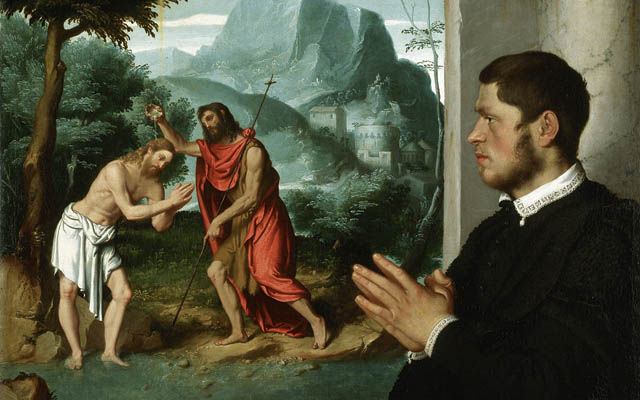Exhibition review: Giovanni Battista Moroni at the Royal Academy
This new exhibition at the Royal Academy, admires the portraiture of Renaissance artist Giovanni Battista Moroni.


In her novel Daniel Deronda, published in 1876, George Eliot described the character Henleigh Mallinger Grandcourt lounging by a fireside after dinner while he smoked. ‘Omitting the cigar,’ she wrote, ‘you might have imagined him a portrait by Moroni, who would have rendered wonderfully the impenetrable gaze and air of distinction.’ And, Eliot added, ‘a portrait by that great master would have been quite as lively a companion’ as Grandcourt who was in a taciturn mood ‘was disposed to be’.
This was a comparison that went both ways: if a 19th-century gentleman might resemble a painting by Giovanni Battista Moroni, it was equally true that the 16th-century Italians in Moroni’s pictures have a strangely Victorian air. Moroni (about 1521–79), whose work is the subject of a major exhibition at the Royal Academy, was an artist who does not seem to fit easily into his own period.
‘One of the chief difficulties of Moroni’s art,’ wrote the art historian Allan Braham, ‘is the problem of “naming” his style, relating his work to the art of his time.’ Moroni’s masterpiece, The Tailor (about 1565–70), is a marvellous work, but remarkable in its earnest realism and sobriety neither of which is a quality that you would associate with the great figures of the Renaissance.
The Tailor depicts a craftsman working at his trade shears in one hand, a piece of cloth in the other. The tailor was presumably a prosperous one, although one suspects that Moroni’s prices were much lower than those of more famous contemporaries such as Titian and Veronese. But there is no attempt to improve his status, or the slightest suggestion of flattery. Behind him is the bare wall of a workshop. He fixes the viewer with an extraordinarily intent look far from humble, but without a hint of arrogance.
When the National Gallery bought The Tailor in 1862, Elizabeth Rigby Eastlake, wife of the director, noted in her diary, ‘This will be a popular picture’. And so it proved. An artist in a Henry James story considered it to be among the half dozen greatest portraits in the world, because of its realism and ‘masterly clearness’. Moroni’s portraits appealed greatly to our ancestors, which is why the National Gallery owns so many of the best of them and it’s not hard to see why. Their sharp focus and warts-and-all truthfulness give them an air of the Daguerreotype.
Those very qualities, however, made Moroni an odd man out in his own times. He came from Albino, a small town in the foothills of the Alps, and worked largely there or in the local metropolises of Bergamo and Brescia. This whole terrain was, almost literally, off the map of the Italian Renaissance. Giorgio Vasari never went to Bergamo, which is probably why Moroni was not even mentioned in his most influential of all books about Renaissance art, The Lives of the Artists. Moroni’s art belongs to a corner of Lombardy close to the border with Switzerland, but distant from Tuscany where tastes and attitudes were different from those in Florence, Rome or even Venice.
Exquisite houses, the beauty of Nature, and how to get the most from your life, straight to your inbox.
In a jibe that might have been directed straight at Moroni, Pietro Aretino, famous author and friend of Titian’s, lamented, ‘To your disgrace, oh century, you allow even tailors and butchers to appear in painting, just as they are!’. Titian himself, according to an anecdote, advised some Venetian officials departing to administer the city of Bergamo that they should have themselves painted by Moroni, who made portraits ‘from nature’.
Within this apparent compliment, there was hidden a subtle put-down. Titian was implying that Moroni’s style and fees were suited to middle-ranking bureaucrats. Such people did not require the grandeur with which Titian himself invested the powerful individuals he painted. A skilful leavening of accuracy with idealisation was the essence of High Renaissance portraiture, as practised by Titian or Raphael.
By that standard, Moroni was, like his sitter, the tailor, a rather lowly craftsman. It is true that his dependence on close observation means that his religious works which required a different sort of imagination are flat-footed. However, as Eliot and her contemporaries discerned, he was a portraitist of compelling power.
‘Giovanni Battista Moroni’ is at the Royal Academy from October 25 to January 25, 2015 (www.royalacademy.org.uk; 020–7300 8000). The fully illustrated catalogue contains contributions from Simone Facchinetti and Arturo Galansino.
Country Life is unlike any other magazine: the only glossy weekly on the newsstand and the only magazine that has been guest-edited by His Majesty The King not once, but twice. It is a celebration of modern rural life and all its diverse joys and pleasures — that was first published in Queen Victoria's Diamond Jubilee year. Our eclectic mixture of witty and informative content — from the most up-to-date property news and commentary and a coveted glimpse inside some of the UK's best houses and gardens, to gardening, the arts and interior design, written by experts in their field — still cannot be found in print or online, anywhere else.
